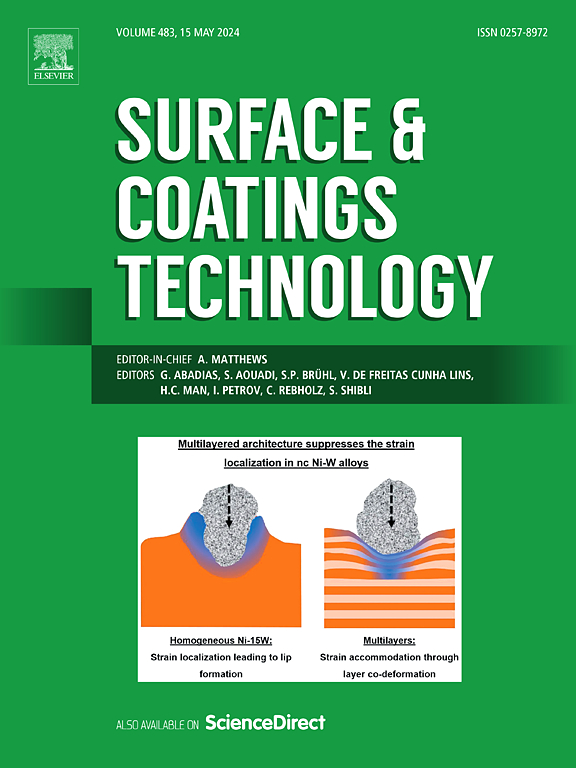Corrosion and mechanical performance of novel electrochemical oxidation coatings on AZ31 magnesium alloys for biomedical applications
IF 5.3
2区 材料科学
Q1 MATERIALS SCIENCE, COATINGS & FILMS
引用次数: 0
Abstract
Magnesium-based implants offer significant benefits for biomedical applications due to their excellent biocompatibility and ability to biodegrade in physiological environments. However, their rapid corrosion can compromise mechanical integrity and hinder clinical translation. This study investigates the corrosion resistance and mechanical integrity of novel soft-sparking electrochemical oxidation (ECO) coatings on AZ31 magnesium alloys, highlighting their potential for biomedical applications. Unlike conventional plasma electrolytic oxidation (PEO), the soft-sparking ECO process operates under milder conditions and avoids dielectric breakdown, producing more uniform, adherent coatings even on complex geometries. Coatings measuring 5, 10, and 15 μm thick were made from five distinct electrolytes: phosphate (P), high phosphate (P(H)), phosphate-silicate (PS), phosphate-fluoride (PF), and phosphate-fluoride-silicate (PFS). These were evaluated regarding porosity, roughness, adherence, and corrosion performance in a 5 M NaCl solution. The most promising coating (PF) was selected for further electrochemical and mechanical analysis, including screw insertion, four-point bending, and scratch testing. Our findings reveal that the coatings reduce corrosion rates by up to 35 times compared to the uncoated alloy while maintaining excellent adhesion even under plastic deformation. Notably, this work presents the first systematic study integrating mechanical integrity assessments with corrosion analysis of soft-sparking ECO coatings on complex magnesium geometries, offering a novel surface modification approach for next-generation biodegradable Mg-based implants.
镁基植入物具有良好的生物相容性和在生理环境中生物降解的能力,因此在生物医学应用中具有显著优势。然而,镁基植入物的快速腐蚀会损害其机械完整性,阻碍临床应用。本研究调查了 AZ31 镁合金上新型软火花电化学氧化 (ECO) 涂层的耐腐蚀性和机械完整性,突出了它们在生物医学应用方面的潜力。与传统的等离子电解氧化(PEO)不同,软火花 ECO 工艺在更温和的条件下运行,避免了介电击穿,即使在复杂的几何形状上也能产生更均匀、更附着的涂层。涂层厚度分别为 5、10 和 15 μm,由五种不同的电解质制成:磷酸盐 (P)、高磷酸盐 (P(H))、磷酸盐-硅酸盐 (PS)、磷酸盐-氟化物 (PF) 和磷酸盐-氟化物-硅酸盐 (PFS)。对这些涂层在 5 M NaCl 溶液中的孔隙率、粗糙度、附着力和腐蚀性能进行了评估。我们选择了最有前景的涂层(PF)进行进一步的电化学和机械分析,包括螺钉插入、四点弯曲和划痕测试。我们的研究结果表明,与未涂层的合金相比,涂层可将腐蚀率降低 35 倍,同时即使在塑性变形的情况下也能保持良好的附着力。值得注意的是,这项研究首次将机械完整性评估与复杂镁基几何形状软火花 ECO 涂层的腐蚀分析相结合,为下一代可生物降解镁基植入物提供了一种新型表面改性方法。
本文章由计算机程序翻译,如有差异,请以英文原文为准。
求助全文
约1分钟内获得全文
求助全文
来源期刊

Surface & Coatings Technology
工程技术-材料科学:膜
CiteScore
10.00
自引率
11.10%
发文量
921
审稿时长
19 days
期刊介绍:
Surface and Coatings Technology is an international archival journal publishing scientific papers on significant developments in surface and interface engineering to modify and improve the surface properties of materials for protection in demanding contact conditions or aggressive environments, or for enhanced functional performance. Contributions range from original scientific articles concerned with fundamental and applied aspects of research or direct applications of metallic, inorganic, organic and composite coatings, to invited reviews of current technology in specific areas. Papers submitted to this journal are expected to be in line with the following aspects in processes, and properties/performance:
A. Processes: Physical and chemical vapour deposition techniques, thermal and plasma spraying, surface modification by directed energy techniques such as ion, electron and laser beams, thermo-chemical treatment, wet chemical and electrochemical processes such as plating, sol-gel coating, anodization, plasma electrolytic oxidation, etc., but excluding painting.
B. Properties/performance: friction performance, wear resistance (e.g., abrasion, erosion, fretting, etc), corrosion and oxidation resistance, thermal protection, diffusion resistance, hydrophilicity/hydrophobicity, and properties relevant to smart materials behaviour and enhanced multifunctional performance for environmental, energy and medical applications, but excluding device aspects.
 求助内容:
求助内容: 应助结果提醒方式:
应助结果提醒方式:


